Modern Workshop Layout Strategies for Maximizing Manufacturing Efficiency最先出现在Dynamics Blog。
]]>The following article uses a real project example from an industrial park workshop to illustrate how Shoebill Technology applies structured evaluation and multi-plan optimization. Through meticulous comparison of four alternative configurations, the company ultimately selected the most balanced and future-ready layout—demonstrating the depth of its expertise in manufacturing workshop layout engineering.
Strategic Thinking Behind Modern Workshop Layout Planning
Shoebill Technology approaches workshop planning as a system-level design exercise. Instead of focusing solely on equipment positioning, the company begins with core operational pillars: production flow logic, in-plant logistics efficiency, vertical movement constraints, and expansion feasibility. This broad perspective ensures that each modern workshop layout not only improves current processes but also supports future operational evolution.
The design logic always starts from the production process itself—mapping upstream and downstream relationships, identifying cross-floor movements, and analyzing environmental requirements such as cleanroom conditions. By doing so, Shoebill Technology ensures that each layout option reflects actual production rhythm rather than theoretical assumptions.
Multi-Scenario Layout for Workshop and Comparative Evaluation
To achieve the most efficient configuration, Shoebill Technology prepared four distinct layout scenarios for the project workshop. Each scheme positioned machining, assembly, and material storage differently to balance logistics, space utilization, and environmental requirements.
Scheme One Streamlined Production Flow on the First Floor
The first configuration placed the South Trina machining center entirely on the first floor (1F), ensuring all major processes avoid cross-floor material transport. Turning and braking machining were grouped near both the dock and the automated warehouse, minimizing manual handling. The second floor (2F) housed the braking cleanroom, isolating cleanliness-sensitive operations from the main production stream.
This design reduced unnecessary vertical logistics, which is often a key pain point in manufacturing workshop layout planning. However, its limited arrangement flexibility became a constraint in later evaluation.
Scheme Two Shortened Internal Logistics With Longitudinal Line Direction
The second scenario adjusted the temporary storage zone of South Trina blanks, positioning it closer to the main aisle. Turning and braking machining remained centrally located on 1F, while production lines were arranged longitudinally to reduce overall transport distances.
The benefit of this layout for workshop efficiency was clear: a more compact flow from storage to machining to assembly. However, the scheme still lacked sufficient reserved space for long-term expansion, which became a limiting factor.
Scheme Three Centralized Machining With Dedicated Cleanroom Planning
In the third configuration, machining areas for both South Trina and the steer-by-wire system were concentrated on 1F. Braking machining was organized within a dedicated cleanroom to enhance quality and reduce contamination risk. This clearly improved process integrity and environmental control.
While the scheme optimally addressed cleanroom planning, its proximity to other high-traffic production zones created potential interference, and vertical logistics remained suboptimal.
Scheme Four Balanced Machining, Assembly, and Logistics Distances
The fourth scenario, which ultimately became the preferred option, separated machining and assembly by floor: South Trina machining on 1F and assembly on 2F. The steering and braking assembly area was aligned with Trina’s 2F operations, forming a cohesive second-floor assembly ecosystem.
This modern workshop layout achieved several advantages simultaneously:
-
High-volume logistics remained on the first floor, reducing vertical transport.
-
All major workshop areas were positioned close to the automated warehouse, significantly shortening material movement distances.
-
The layout included generous reserved expansion areas, ensuring future production scalability.
-
Its structure separated visitor pathways from production activities, allowing visibility without operational disruption.
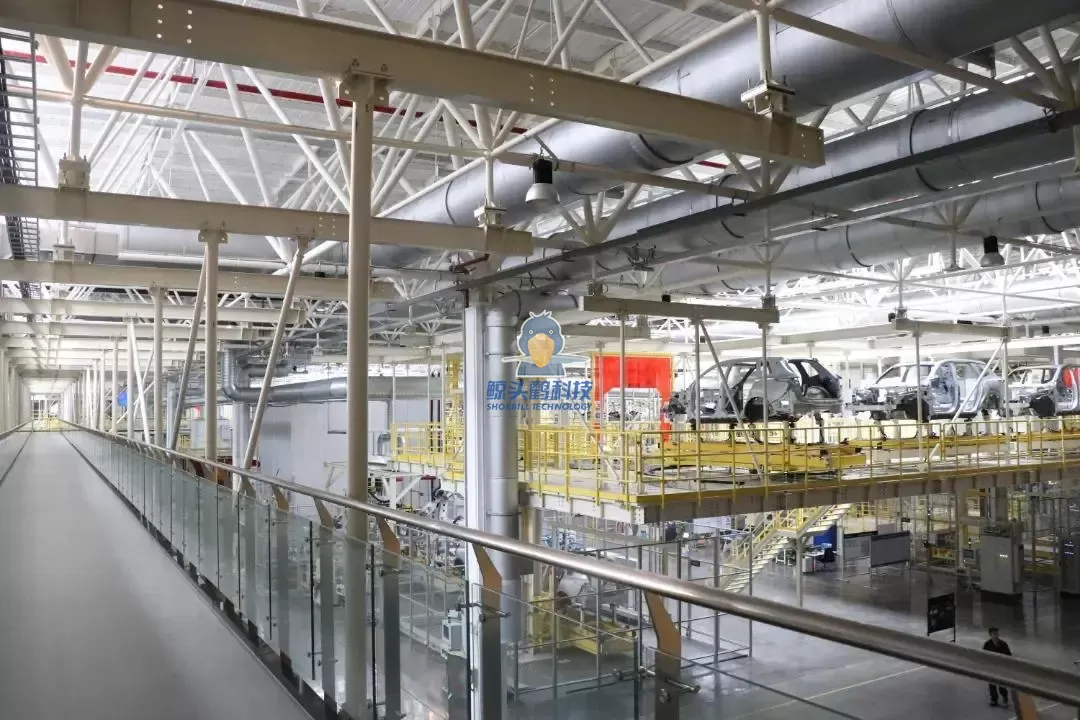
Key Evaluation Dimensions in Manufacturing Workshop Layout Design
Shoebill Technology compared the four schemes using a structured evaluation matrix based on four key criteria.
Cross-Floor Transport and Cleanroom Configuration
The company examined how each layout handled vertical movement of high-volume materials and whether cleanroom areas were positioned logically relative to upstream and downstream processes. Minimizing cross-floor flow is essential in modern workshop layout engineering because it directly influences cycle time and labor intensity.
Manufacturing Logistics and Distance to Warehouse
Each scheme was analyzed for:
-
total material conveyance distance
-
proximity to the automated warehouse
-
congestion risk along major aisles
This data-driven approach ensured that the selected layout for workshop minimized wasted motion and supported smooth replenishment.
Scalability and Reserved Area Planning
Future production expansion is a critical consideration. Shoebill Technology evaluated whether each scenario included flexible, reconfigurable spaces that could accommodate:
-
new machining lines
-
cleanroom enlargement
-
future automation upgrades
Scheme Four stood out for its clear reserve areas and logical expansion direction.
Visitor Access and Non-Interference Design
An often-overlooked criterion in workshop planning is the ability to support structured visits without disrupting operations. Shoebill Technology mapped viewing routes and employee pathways to ensure:
-
safe visitor circulation
-
no interference with material flow
-
adequate transparency into core processes
Scheme Four provided the most coherent separation of logistics and visitor circulation.
Why Scheme Four Became the Optimal Manufacturing Workshop Layout
After a comprehensive comparison, Scheme Four was selected because it represented the most balanced, scalable, and logistics-optimized design. Its defining strengths included:
-
Large logistics volumes concentrated on 1F, reducing vertical material handling.
-
Short transport distances to the automated warehouse for all major functional areas.
-
Extensive reserved space, supporting continuous capacity expansion.
-
Cleaner separation of machining, assembly, and visitor pathways, improving safety and visibility.
This solution showcased Shoebill Technology’s precise control of micro-level layout variables—demonstrating how thoughtful design transforms operational efficiency.
Broader Significance of Precision Workshop Layout Engineering
Shoebill Technology’s project illustrates a broader truth: modern manufacturing competitiveness is increasingly defined by the intelligence of plant layout decisions. A refined manufacturing workshop layout enhances more than just daily production—it influences labor efficiency, inventory turnover, quality stability, and the ease of future automation integration.
By integrating scenario simulation, quantitative comparison, and long-term strategic thinking, Shoebill Technology delivers workshop layouts that are not merely functional but operationally transformative. The selected scheme reflects the company’s deep understanding of industrial workflows and its ability to translate complex constraints into elegant, efficient spatial solutions.
As factories evolve toward greater automation and digitalization, Shoebill Technology’s precision-driven approach to workshop layout will continue to unlock new levels of efficiency and performance for manufacturers seeking sustainable growth.
https://www.shoebilltech.com/blogs/how-modern-manufacturing-workshop-layouts-can-improve-efficiency.
Shoebill Technology
Modern Workshop Layout Strategies for Maximizing Manufacturing Efficiency最先出现在Dynamics Blog。
]]>Российское зарубежное складирование
Компания CGS стремится стать профессиональным сторонним поставщиком услуг складирования и логистики в сфере поставок в России, уделяя особое внимание предоставлению комплексных услуг по складированию, обработке и управлению дистрибуцией для китайско-российской отрасли электронной коммерции.
CGS Russia Overseas Warehouse в основном обслуживает китайских и российских торговцев, которым требуются услуги складирования, обработки и дистрибуции в сфере электронной коммерции, включая, помимо прочего, компании, работающие на платформах электронной коммерции, торговцев, работающих на платформах, и независимые компании B2C.
Модель продукции CGS для зарубежного складирования:
1. Используйте профессиональные склады. Унифицированные склады высокого стандарта + эпоксидный пол + пожарная инспекция + ручная уборка + 24-часовой динамический интеллектуальный мониторинг + десятки миллионов имущественных страховок. Складские операции полностью поддерживают управление штрих-кодами и управление ERP и работают в соответствии с унифицированными стандартизированными процессами.
2. Предоставлять комплексное обслуживание. Помогать клиентам выполнять ряд задач, включая складирование продукции, проверку качества, хранение, сортировку, упаковку, сопоставление заказов, назначение, доставку, возврат и обмен и т. д.
Возможности профессиональных системных ИТ-решений. Охватывает систему управления складом, систему управления дистрибуцией, систему управления центром обслуживания клиентов, обеспечение управления поступлением и вывозом товаров со склада, управление запасами, управление заказами на печать, управление сортировкой товаров, управление упаковкой, управление возвратами, управление складом, управление поставщиками, управление мониторингом полного процесса и т. д. Своевременный веб-запрос на выполнение заказа, запрос информации о срочном заказе, своевременная обработка информации о заказе в течение 7 часов по 12 часов и т. д.
4. Профессиональная команда. Основные члены команды CGS Russia Overseas Warehouse имеют многолетний опыт работы в сфере электронной коммерции, управления складированием и логистикой, разработки, эксплуатации и обслуживания систем.
https://www.cgs-express.net/russian-overseas-warehousing.html
Superlight International Logistics
Pioneering Smart Factory Design with Digital Lean Layout Strategies最先出现在Dynamics Blog。
]]>A Systematic Approach to Lean Manufacturing Plant Layout
Shoebill Technology’s lean manufacturing plant layout approach is deeply rooted in the classic SLP (Systematic Layout Planning) method. By analyzing five key dimensions—Product (P), Quantity (Q), Routing (R), Supporting departments (S), and Time (T)—the company ensures that every element of production is considered in a holistic and data-informed manner.
This multi-angle analysis starts with the mapping of logistical and non-logistical relationships, followed by the creation of detailed operation unit relationship diagrams. Through iterative comparisons of multiple design options, Shoebill identifies the optimal lean production layout that minimizes waste, enhances flow efficiency, and ensures long-term adaptability.
Smart Factory Layout: Balancing Efficiency and Sustainability
In modern manufacturing, balancing efficiency with sustainability is a strategic necessity. Shoebill Technology’s smart factory layout incorporates not only functional zoning and material flow but also environmental performance. In one case study involving a 600-acre automotive component park (with a planned area of 306 acres), Shoebill’s team aligned every design decision with municipal requirements, road infrastructure, and production capacity goals.
For example, to meet the annual production targets of 300,000 shock absorber towers and 200,000 battery housings, Shoebill precisely calculated the number of machines, the size of each functional zone, and the required warehouse capacity. The plan included two melting furnaces, two die-casting machines, and two production lines—each positioned based on optimized process flow and equipment utilization.
The lean factory layout also adhered to strict architectural parameters, such as a building density above 45%, a floor area ratio between 1.0 and 1.5, and a green space ratio of 10–20%. Moreover, Shoebill integrated “sponge city” principles into its smart factory design, enabling efficient rainwater management and resource recycling within the industrial site.
Data-Driven Decisions for Smarter Industrial Planning
Shoebill Technology’s success in lean manufacturing layout lies in its deep integration of digital simulation and data analytics. Each layout proposal undergoes rigorous virtual validation using 3D modeling and simulation tools, allowing planners to visualize production flow, material handling paths, and spatial utilization before implementation.
This data-driven approach significantly reduces redesign risks, supports agile decision-making, and provides valuable insights for capacity expansion or product line adjustments in the future. By aligning lean manufacturing layout principles with digital engineering, Shoebill enables enterprises to achieve higher levels of transparency, flexibility, and operational efficiency.
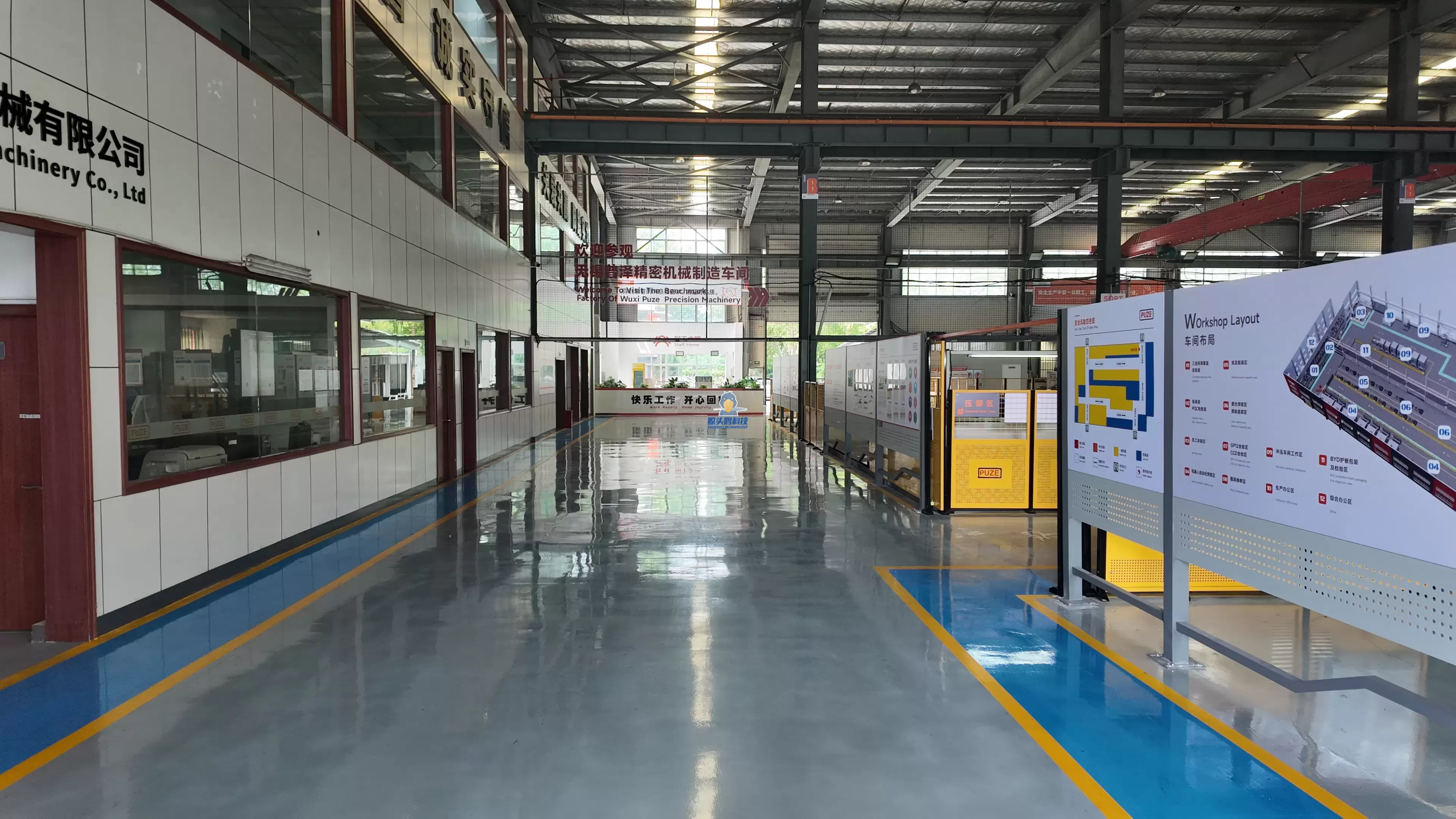
From Lean Thinking to Intelligent Execution
While lean manufacturing emphasizes waste reduction and process efficiency, Shoebill Technology extends this philosophy into the realm of intelligence and automation. In its lean manufacturing plant layout, digital sensors, IoT systems, and real-time monitoring platforms are embedded into every stage of the production network.
This digital backbone not only enables predictive maintenance and energy optimization but also empowers factories to make informed, adaptive decisions on the fly. As a result, Shoebill’s smart factory layout solutions serve as both an operational roadmap and a digital infrastructure blueprint—supporting continuous improvement and sustainable growth.
Case Study: Precision Planning for Automotive Component Manufacturing
The automotive component park project is a testament to Shoebill’s ability to balance complexity, scalability, and compliance. Under constraints such as limited land, strict municipal guidelines, and high production demands, Shoebill leveraged its lean factory layout expertise to maximize space utilization without compromising production efficiency.
By aligning every aspect of factory planning—from logistics routes and energy systems to personnel flow and emergency access—Shoebill created a cohesive lean plant layout that supports both short-term performance and long-term industrial evolution. The result was a facility that not only met immediate capacity targets but also maintained flexibility for future technology integration.
Redefining Industry Standards with Lean and Smart Integration
As global manufacturing continues its digital transformation, Shoebill Technology exemplifies how lean production layout principles can harmonize with advanced digital planning tools to build the factories of the future. Its strategy goes beyond traditional efficiency metrics—it embraces the idea that the smartest factories are those that continuously learn, adapt, and evolve.
By uniting lean manufacturing layout principles with the intelligence of digital systems, Shoebill is not just optimizing factory space—it is redefining how industrial ecosystems operate. The company’s vision of creating agile, data-driven, and environmentally conscious production environments is reshaping the landscape of smart factory design worldwide.
Conclusion
Shoebill Technology’s digital and lean-based approach represents a forward-thinking blueprint for next-generation manufacturing. Through its mastery of lean plant layout, digital simulation, and smart factory layout innovation, the company is leading enterprises toward sustainable, intelligent, and resilient industrial transformation.
In a world where manufacturing must be both efficient and adaptive, Shoebill Technology stands as a model of how strategic lean manufacturing plant layout can become the foundation of an intelligent, future-ready production system.
https://www.shoebilltech.com/blogs/smart-factory-design-with-digital-lean-layout-strategies.html
Shoebill Technology
Pioneering Smart Factory Design with Digital Lean Layout Strategies最先出现在Dynamics Blog。
]]>Smart Strategies for Manufacturing Factory Layout Design最先出现在Dynamics Blog。
]]>In modern industrial production, manufacturing factory layout design plays a critical role in ensuring efficiency, cost reduction, and overall operational excellence. A well-planned facility layout is not just about arranging equipment; it involves integrating workflow, safety standards, and future scalability. Companies that invest in professional layout planning can improve throughput, minimize waste, and create a foundation for sustainable growth.
Principles of Efficient Plant Floor Organization
The backbone of any production facility arrangement lies in its guiding principles. These principles include the smooth flow of materials, logical sequencing of processes, flexibility for expansion, and ergonomic considerations for workers. For example, minimizing unnecessary movement between stations reduces cycle time and enhances productivity. Lean manufacturing concepts, such as value stream mapping, are often applied during the design stage to align layout choices with strategic goals.
Role of Technology in Factory Space Planning
Digital tools have transformed factory space optimization. Advanced simulation software allows manufacturers to model different configurations before implementation. By running virtual scenarios, planners can identify bottlenecks, predict equipment utilization, and measure the impact of layout adjustments. The integration of IoT sensors and AI-driven analytics further enables real-time data collection, helping factories continuously refine their layout strategies.
Safety and Compliance in Industrial Layouts
An often overlooked aspect of industrial layout design is workplace safety. Factories must comply with strict regulations regarding emergency exits, ventilation, fire prevention, and employee safety zones. Poorly designed layouts can create hazards such as blocked pathways or insufficient clearance around machinery. Effective planning ensures that compliance is embedded into the design, reducing risks and potential legal liabilities.
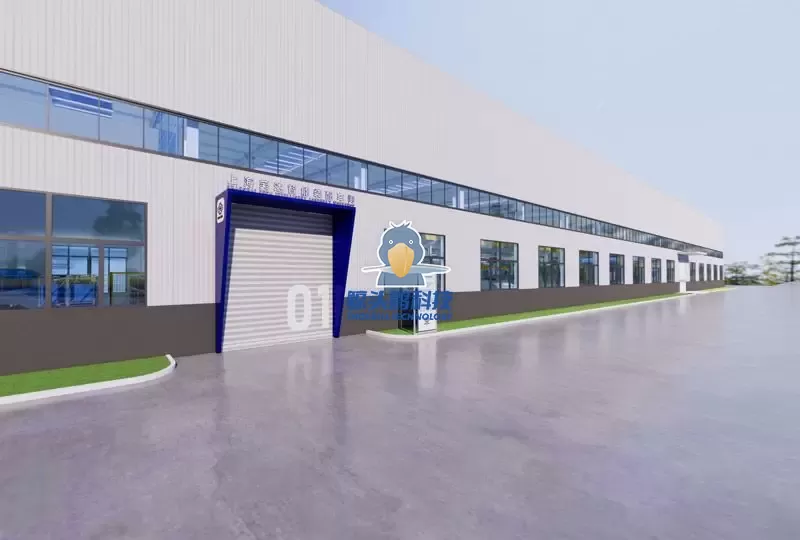
Balancing Automation and Human Workflows
The rise of automation has reshaped production line layout planning. Collaborative robots (cobots), automated guided vehicles (AGVs), and conveyor systems require precise spatial integration with human-operated tasks. Striking the right balance between human workflows and automated processes not only enhances efficiency but also prevents workplace congestion. This hybrid approach maximizes productivity without compromising worker safety.
Sustainable Approaches to Factory Arrangement
Sustainability is increasingly influencing plant layout engineering. Energy-efficient layouts may include natural lighting, optimized HVAC systems, and renewable energy integration. Positioning equipment to minimize heat loss or recovery of waste energy can reduce operational costs and carbon footprint. Green factory layouts also consider material reuse and recycling zones, aligning with corporate social responsibility goals and regulatory expectations.
Case Studies in Modern Layout Planning
Examining examples of manufacturing facility design highlights how theory translates into practice. Automotive factories, for instance, often adopt U-shaped layouts that enhance visibility and reduce travel distances for workers. Electronics manufacturers may opt for modular layouts to allow quick adaptation to new product lines. These real-world cases demonstrate how strategic layout decisions align with industry-specific requirements.
Future Trends in Factory Layout Optimization
The future of facility layout design is moving toward smart, adaptive systems. With the adoption of Industry 4.0 technologies, layouts will become increasingly dynamic, capable of adjusting in response to demand fluctuations. Mobile robots and reconfigurable production lines will give factories the agility to switch between products rapidly. Additionally, digital twins—virtual replicas of the physical factory—will be instrumental in predicting and improving layout performance continuously.
Overcoming Common Challenges in Layout Development
Despite its benefits, factory planning and layout faces challenges such as budget limitations, space constraints, and resistance to change. Retrofitting older facilities can be particularly complex due to structural restrictions. To overcome these challenges, businesses often employ phased implementation, pilot projects, and employee training programs. These measures ensure that new layouts are practical, cost-effective, and well-accepted by staff.
Conclusion
An effective manufacturing factory layout design is not a one-time project but an ongoing process of improvement. By combining strategic planning, advanced technology, safety compliance, sustainability practices, and adaptability, manufacturers can create layouts that serve as the backbone of their operations. In a competitive global market, the factories that excel are those that continuously refine their layouts to balance efficiency, innovation, and resilience.
https://www.shoebilltech.com/blogs/smart-strategies-for-manufacturing-factory-layout-design.html
Shoebill Technology
Smart Strategies for Manufacturing Factory Layout Design最先出现在Dynamics Blog。
]]>Formation Drone Light Show: Future of Aerial Artistry最先出现在Dynamics Blog。
]]>In recent years, the formation drone light show has emerged as one of the most innovative and breathtaking forms of entertainment. Using synchronized fleets of unmanned aerial vehicles (UAVs), these displays create dazzling three-dimensional patterns, transforming the night sky into a canvas of light and motion. This technology has gone beyond traditional fireworks, offering not only visual wonder but also precision, sustainability, and limitless creative possibilities. In this blog post, as a professional indoor and outdoor drone exporter, Highgreat will share the innovative application of formation drone light show, its advantages, etc.
Concept Behind Aerial Light Formations
The essence of a drone formation show lies in coordinated flight programming. Each drone is fitted with LED lights and operates on a centralized control system that guides its path. Advanced algorithms ensure that hundreds—or even thousands—of drones fly in unison without collisions. This synchronization allows the creation of recognizable shapes, animations, and storytelling sequences in the sky. Unlike fireworks, the drones can be reprogrammed to shift between multiple formations in a single performance, enabling more dynamic narratives.
Creative Applications of Drone Sky Shows
The versatility of formation drone light performances has expanded their use across industries. Corporations utilize them during product launches to showcase logos and 3D branding elements in the sky. Governments adopt them for national celebrations, while cities employ them to enhance cultural festivals. Sports events integrate aerial storytelling to energize audiences, and music concerts use them to amplify emotional impact. Beyond entertainment, these shows have educational potential, visualizing complex scientific concepts or historical events in ways that captivate public attention.
How Formation Drone Light Shows Compare to Fireworks?
One of the most discussed aspects of the drone light show formation is how it compares to fireworks. Fireworks deliver powerful bursts of color but are fleeting, loud, and environmentally taxing. Drones, on the other hand, provide silence, reusability, and programmable versatility. Their movements can be timed with music or narration, offering audiences an immersive multimedia experience. Additionally, drone-based sky displays eliminate smoke and debris, making them a sustainable alternative that aligns with modern environmental awareness.
Technical Foundations of Aerial Choreography
Behind every drone formation light event is an intricate network of software, hardware, and flight engineering. Operators design animations using specialized software that translates visual concepts into flight paths. GPS positioning and real-time communication enable drones to follow pre-defined routes with remarkable accuracy. Backup systems are integrated to handle emergencies, ensuring safety during live performances. Moreover, advancements in battery life, LED brightness, and AI-based collision avoidance continue to push the boundaries of what is possible in aerial art.
Role of Creativity in Drone Sky Performances
While the engineering behind a drone formation display is impressive, creativity drives its impact. Choreographers and digital designers collaborate to craft meaningful stories that unfold in the air. From forming iconic monuments to recreating animals, symbols, or abstract art, the range of visuals is vast. Pairing these images with music and narration deepens the audience’s emotional connection, transforming the show into more than just a spectacle—it becomes a narrative experience written across the sky.
Cultural Influence and Public Reception
The popularity of formation drone spectacles is evident in their growing presence at global events. Audiences often describe these shows as futuristic and emotionally stirring. Social media amplifies their influence, with viral videos spreading worldwide within minutes. This digital sharing not only boosts cultural visibility but also encourages innovation as different cities and organizations strive to outdo previous displays. In this way, drone artistry is shaping a new cultural language of celebration.
Environmental and Social Implications
A significant reason behind the rise of drone formation entertainment is its ecological advantage. Fireworks contribute to air and noise pollution, while drones operate without harmful emissions or hazardous waste. Communities with strict noise regulations find drone shows an ideal alternative, particularly for families, children, and pets sensitive to loud explosions. Socially, these displays promote inclusivity by being accessible in diverse settings, from urban centers to eco-sensitive natural environments.
Challenges in Large-Scale Drone Displays
Despite their appeal, formation drone light events face certain challenges. Weather conditions such as strong winds, rain, or fog can disrupt performances. Technical malfunctions, although rare, require contingency planning. High costs of equipment and skilled personnel also limit accessibility for smaller organizations. However, as technology matures, costs are expected to decrease, making drone artistry more widely available. These challenges are actively being addressed, ensuring steady progress in performance reliability.
Future of Drone-Based Light Shows
Looking ahead, the potential of formation drone light art is boundless. As AI and real-time control systems advance, shows could become interactive, responding to audience movements or live music. Integration with augmented reality may allow viewers to experience layered dimensions of the same performance through wearable devices. Moreover, expanding battery capacity and lightweight materials will enable longer, more complex displays. In the future, drone shows might evolve into permanent city attractions, much like fountains or laser installations.
Conclusion: A New Era of Sky Performance
The rise of the formation drone light show signals a profound shift in how humanity experiences collective celebration and storytelling. By merging technology, sustainability, and artistry, these aerial displays transcend traditional entertainment. They are not only captivating audiences but also setting a foundation for environmentally responsible cultural expression. As innovation continues, drone-based light art will remain at the forefront of redefining how we paint the sky.
https://en.hg-fly.com/news/innovative_application_of_formation_drone_light_show.html
Highgreat
Formation Drone Light Show: Future of Aerial Artistry最先出现在Dynamics Blog。
]]>Lean Factory Layout: Designing Efficiency into Manufacturing System最先出现在Dynamics Blog。
]]>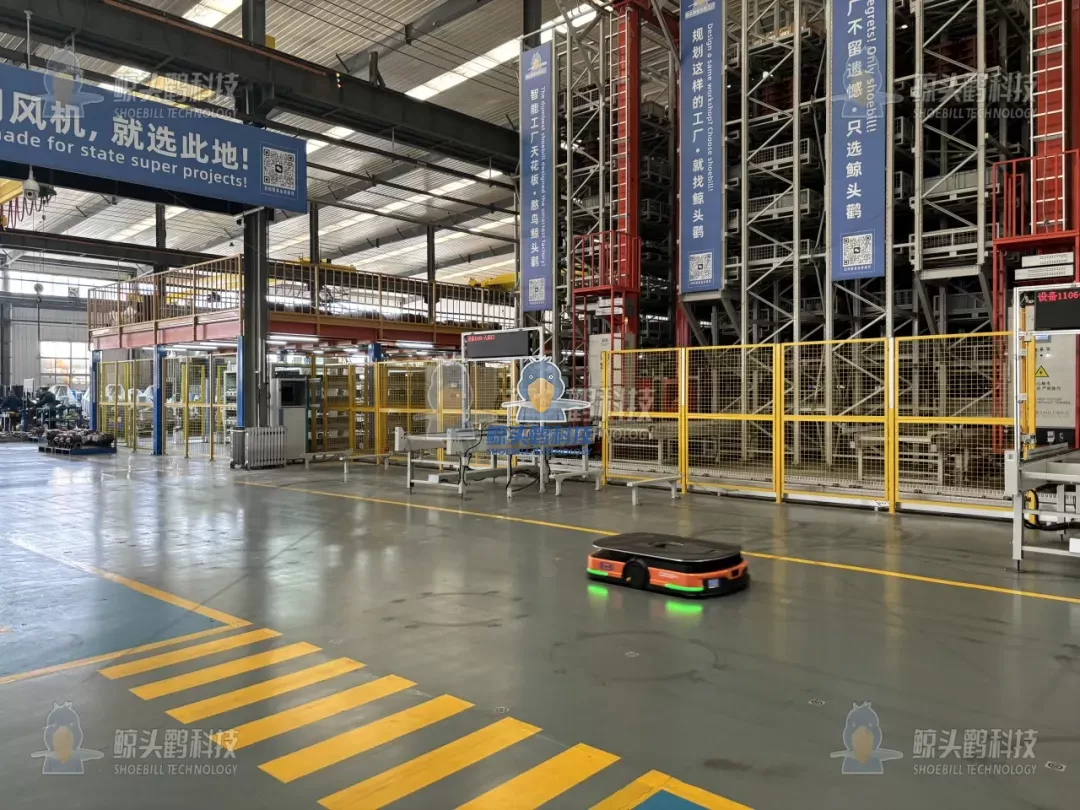
Core Objectives of Lean Factory Layout
The primary goal of a lean manufacturing plant layout is to build a system that promotes smooth flow, flexible operations, and minimal waste. Rather than treating each department as a silo, a lean layout integrates processes into a connected ecosystem. The key outcomes include:
-
Shorter production cycles through streamlined workflows.
-
Reduced inventory levels by cutting unnecessary buffers.
-
Improved space utilization with compact and logical arrangements.
-
Stable quality performance by reducing errors caused by poor handling.
-
Enhanced flexibility to quickly adapt to market or product changes.
In short, a lean factory layout converts a “collection of machines” into a synchronized production system that behaves as one cohesive unit.
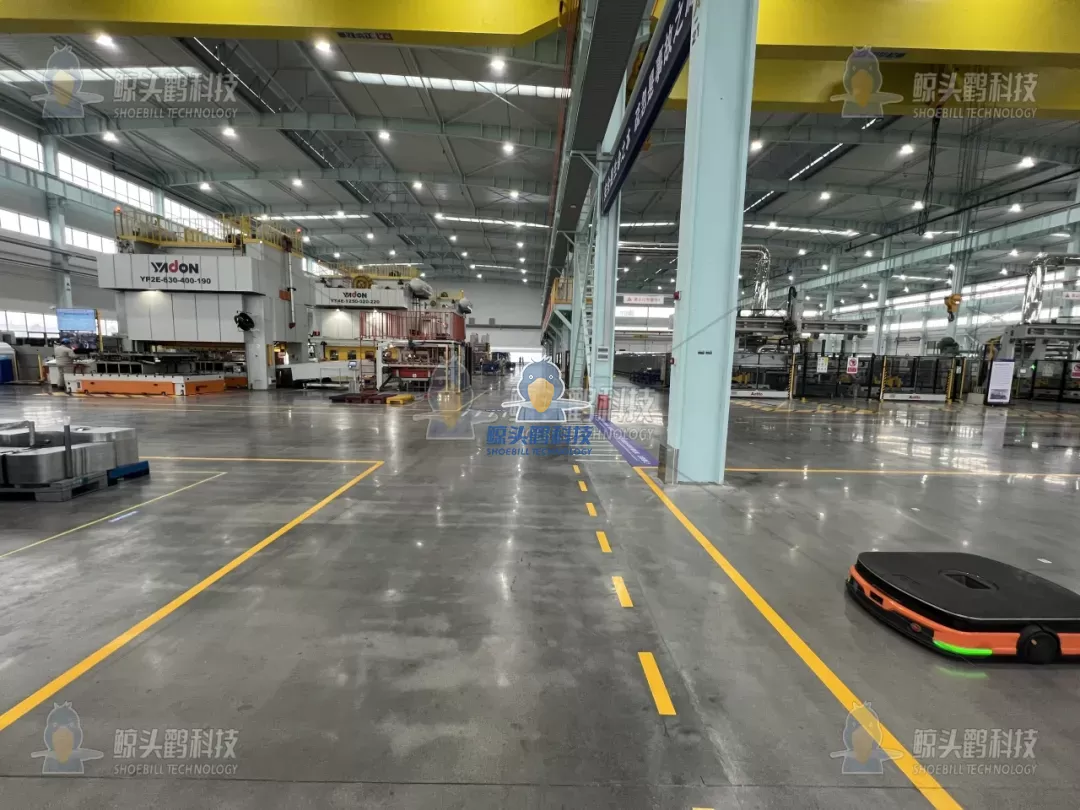
Seven Guiding Principles for Lean Factory Layout Design
When rethinking factory design, manufacturers must go beyond surface-level changes. A lean production layout relies on universal principles that ensure flow, safety, and efficiency.
1. Prioritize Smooth Logistics Flow
The first principle of a lean facility layout is to create continuous and clear material flow paths. By eliminating unnecessary crossings, backtracking, or stoppages, materials reach production lines with minimal friction.
2. Minimize Transportation Distance
Every extra meter of movement adds cost and delays. A lean shop floor layout minimizes transport distance between workstations, ensuring tools, materials, and products move in the shortest possible path.
3. Maximize Space Utilization
Large empty areas or cluttered storage corners drain efficiency. Through compact design and optimized storage, space utilization can improve by 30% or more, turning wasted space into productive value.
4. Build Flexibility into the Layout
Markets evolve, and production requirements shift. A flexible lean factory layout leaves room for line adjustments, modular expansions, or product mix changes without requiring full-scale redesign.
5. Ensure Seamless Process Connections
By reducing intermediate storage and ensuring processes are tightly linked, a lean layout avoids delays and accelerates flow. Modular work cells often replace traditional long lines, increasing adaptability.
6. Support Human-Machine Collaboration
Operators remain central to lean systems. Layouts must ensure ergonomics, safety, and convenience, creating a user-friendly environment that reduces fatigue and boosts productivity.
7. Integrate Environmental Optimization
Lighting, ventilation, and noise control are not afterthoughts—they directly impact efficiency and employee well-being. A sustainable lean layout considers these factors from the planning stage.
Five-Step Path to Implementing a Lean Factory Layout
Designing a lean manufacturing plant layout is not an overnight project. It follows a structured path that ensures alignment with production needs and future growth.
Step 1: Define Capacity and Production Rhythm
Planners first determine annual output, hourly production rates, and takt time. These metrics serve as the foundation for layout decisions.
Step 2: Focus on Core Products with PQ Analysis
Pareto analysis helps identify which products drive the most value. Resources and space are then allocated based on these priorities, ensuring critical lines receive the necessary support.
Step 3: Optimize Material Handling and Storage
Instead of large centralized warehouses, lean layouts favor “supermarket-style” decentralized storage close to the production line. This reduces handling and keeps material flow continuous.
Step 4: Incorporate Environmental Improvements
Factory layouts should address real-world challenges such as poor airflow or excessive heat. Integrating ventilation systems, natural lighting, and safety enhancements ensures long-term usability.
Step 5: Compare and Select the Best Layout Option
Planners typically design multiple layout alternatives, evaluating them against performance, flexibility, cost, and safety. The chosen plan balances efficiency with adaptability.
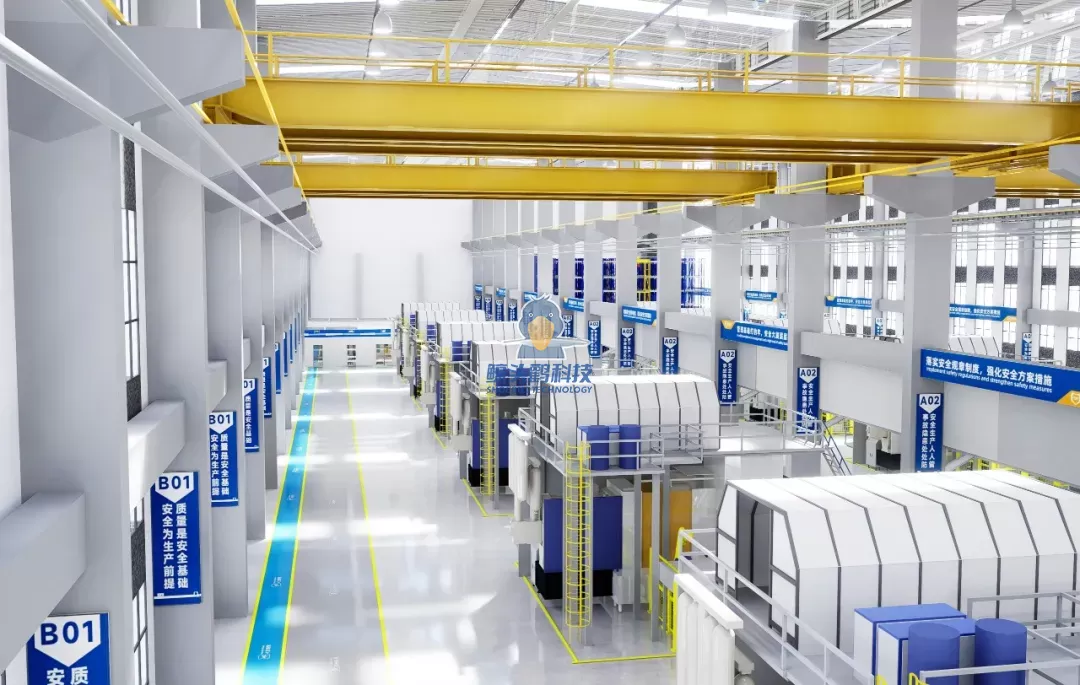
Key Success Factors for Lean Layout Implementation
Designing a lean layout is only half the journey. The real challenge lies in execution. Several factors determine whether the new layout will succeed:
-
Leadership Commitment – Senior management must actively support and champion lean transformation.
-
Cross-Department Collaboration – Production, logistics, maintenance, and safety teams must coordinate from planning to execution.
-
Employee Engagement – Operators provide valuable insights on workflow and ergonomic needs; their participation ensures practical results.
-
Embedded Lean Culture – Without embedding lean principles into daily operations, even the best layout may fail to deliver long-term benefits.
A lean production plant layout is not a one-time project but an evolving framework that continuously adapts as processes improve.
Benefits of Lean Factory Layout for Smart Manufacturing
In the era of Industry 4.0, factories are moving toward intelligent and connected systems. A smart lean factory layout is the foundation that enables digital tools—such as automated guided vehicles (AGVs), IoT sensors, and real-time data tracking—to function effectively. The benefits include:
-
Higher efficiency through seamless integration of automation and manual processes.
-
Faster response times to market demand changes.
-
Sustainable cost reduction by lowering waste and energy consumption.
-
Scalable growth through modular and flexible design.
By combining lean layout design with smart technologies, manufacturers build plants that are both efficient today and adaptable for tomorrow.
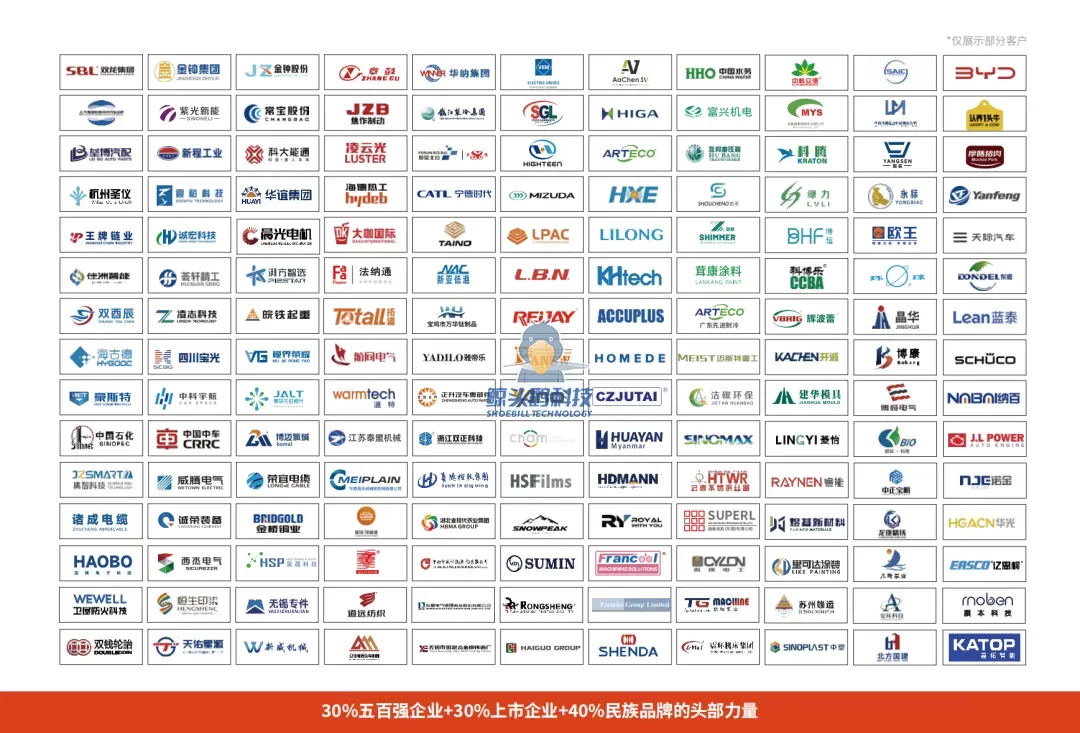
Conclusion
The design of a factory is not merely about equipment placement—it defines how effectively a business can compete in today’s global market. A lean factory layout turns manufacturing facilities into dynamic, waste-free systems that respond quickly to customer demand while keeping costs low.
By adhering to lean principles, following structured implementation steps, and fostering a culture of collaboration, companies can transform their operations into true smart factories. In the end, the right layout is not just a blueprint—it is the strategic engine that drives long-term success.
https://www.shoebilltech.com/blogs/lean-factory-layout-design-in-manufacturing-system.html
Shoebill Technology
Lean Factory Layout: Designing Efficiency into Manufacturing System最先出现在Dynamics Blog。
]]>Outdoor Drone Light Show Design: Innovations in Aerial Performance最先出现在Dynamics Blog。
]]>Why Outdoor Drone Light Show Design Is Gaining Popularity
The growing demand for immersive entertainment experiences has made outdoor drone light show design a top choice for global events. Unlike fireworks, drone shows produce no noise pollution, minimal environmental impact, and can be reused for multiple performances. They also offer flexibility in design, enabling shows that tell stories or reflect cultural themes, corporate identities, or seasonal celebrations.
Key Factors Driving Demand:
-
Environmental sustainability: Zero emissions and reusable technology.
-
Safety: Reduced fire hazards compared to fireworks.
-
Customization: Tailored aerial designs for brands, festivals, and ceremonies.
-
Innovation: Ability to incorporate logos, characters, and messages into the sky.
Core Principles of Drone Light Show Design
When planning an outdoor drone light show design, several fundamental principles guide the process. These principles ensure the show is visually stunning, technically reliable, and audience-friendly.
-
Creative Conceptualization – Designers first determine the theme or story, such as a national celebration, sports event, or product launch.
-
Spatial Planning – The number of drones, flight altitudes, and formations must be carefully planned to maximize visibility.
-
Lighting Coordination – LED brightness, color gradients, and timing are adjusted for clarity and impact.
-
Safety Protocols – Wind resistance, flight zones, and emergency procedures are integrated into the design.
Outdoor Drone Show Design and Technology Integration
Advanced software and AI algorithms play a central role in drone light show design. Designers use 3D modeling tools to simulate aerial formations before live execution. This ensures synchronization between hundreds, or even thousands, of drones.
Technological Elements:
-
GPS Precision Navigation: Ensures accurate flight paths.
-
Swarm Intelligence: Coordinates multiple drones without collision.
-
Battery Efficiency: Extends show duration while minimizing mid-air risks.
-
LED Innovations: Full RGB color systems enable dynamic visuals.
By merging design creativity with robust software platforms, drone shows can deliver stunning visual effects comparable to high-end cinematic experiences.
Outdoor Drone Light Show Design for Events and Celebrations
From international sporting ceremonies to corporate brand launches, outdoor drone light show design adapts seamlessly to various event scales. The ability to incorporate branding elements or cultural symbols into aerial displays makes drone shows especially appealing to organizers.
-
Festivals and Holidays: Drones replace fireworks with quieter, eco-friendly alternatives.
-
Corporate Branding: Aerial logos and product designs captivate audiences.
-
Sports and Stadium Events: Choreographed formations highlight team mascots or iconic symbols.
-
Weddings and Private Celebrations: Personalized displays offer unforgettable memories.
Challenges in Outdoor Drone Light Show Design
Despite its many advantages, outdoor drone light show design faces challenges that require technical expertise and careful planning.
-
Weather Conditions – Strong winds, rain, or low visibility can disrupt flights.
-
Regulatory Compliance – Airspace permissions and local aviation laws vary by region.
-
Battery Limitations – Current battery technology limits flight times to 10–20 minutes.
-
Cost Factors – High initial setup and maintenance costs may deter smaller events.
Overcoming these challenges requires collaboration between designers, engineers, and regulatory authorities.
Sustainability in Drone Light Show Design
One of the strongest appeals of outdoor drone light show design lies in its environmental sustainability. Unlike fireworks, drones produce no harmful chemicals, no debris, and no noise pollution that disturbs wildlife or communities. Additionally, drones can be reused indefinitely with proper maintenance, reducing overall environmental impact.
Green Event Solutions:
-
Reusable drone fleets.
-
Energy-efficient LED technology.
-
Minimal air pollution compared to fireworks.
-
Reduced community disturbance.
Future of Outdoor Drone Light Show Design
As drone technology continues to advance, the future of outdoor drone light show design will bring even more exciting possibilities. Artificial intelligence, augmented reality integration, and longer battery life will allow for more complex and interactive displays.
Emerging Trends:
-
Interactive Audience Participation: Smartphone apps enabling viewers to influence designs.
-
Hybrid Shows: Integration of drones with lasers, projections, and soundscapes.
-
Massive Scale Performances: Thousands of drones synchronized for global events.
-
Sustainable Innovations: Solar-powered drone charging stations for eco-friendly operations.
Conclusion
The evolution of outdoor drone light show design marks a new era in public entertainment and storytelling. With its combination of creativity, technology, and sustainability, drone shows have become a symbol of modern innovation. Whether for festivals, corporate branding, or global celebrations, drone light shows captivate audiences with unforgettable visual experiences while reducing environmental harm.
As technology evolves, the potential of outdoor drone light shows will continue to expand, redefining how humanity celebrates milestones in the night sky.
https://en.hg-fly.com/news/outdoor_drone_light_show_design.html
Highgreat
Outdoor Drone Light Show Design: Innovations in Aerial Performance最先出现在Dynamics Blog。
]]>How Fabric Quality Inspection Safeguards Your Textile Supply Chain最先出现在Dynamics Blog。
]]>What Is Fabric Quality Inspection?

Fabric quality inspection is a systematic procedure aimed at ensuring textile materials—whether woven, knitted, or non-woven—meet both industry and buyer-defined standards. This process involves evaluating fabrics for visible defects, measuring physical dimensions, and testing performance attributes to ensure suitability for downstream processes like cutting, sewing, and garment assembly. A comprehensive inspection reduces risks of production delays, customer complaints, and reputational damage.
Inspections can take place at multiple stages of the supply chain:
-
Pre-production (Greige Fabric Inspection): Identifies defects in unfinished fabrics before dyeing or finishing, allowing mills to correct issues early.
-
In-line Inspection (During Production): Monitors fabric quality in real time to detect defects before large volumes are produced.
-
Post-production (Finished Fabric Inspection): Evaluates dyed or finished fabrics for compliance with final specifications.
-
Pre-shipment Inspection: Conducted just before delivery to confirm that the bulk order meets buyer requirements.
By implementing fabric quality inspection across these checkpoints, manufacturers and exporters can maintain consistent product quality and improve buyer confidence.
Why Fabric Quality Inspection Matters in Global Trade
1. Reduces Return Rates and Quality Complaints
In global trade, even minor defects can cause shipment rejections. By identifying issues such as color variations, weaving flaws, or oil stains at the source,fabric quality inspection helps suppliers avoid costly returns and protect profit margins. Early detection ensures fabrics are rectified or replaced before reaching international buyers, preventing disputes and safeguarding long-term business relationships.
2. Ensures Compliance With Buyer Specifications
Buyers often set detailed technical specifications covering GSM, shrinkage, tensile strength, and colorfastness. Comprehensive fabric quality inspection provides documented evidence that these requirements are met. This not only builds buyer trust but also reduces the likelihood of penalties, rework, or reputational harm in competitive export markets.
3. Supports Production Efficiency
When defective fabrics enter cutting and sewing, they create alignment issues, stitching problems, and higher scrap rates. By filtering out defective rolls through fabric quality inspection, manufacturers ensure smoother downstream production. This results in fewer machine stoppages, less rework, and reduced fabric wastage, ultimately lowering production costs and improving delivery timelines.
4. Enhances Brand Reputation
Brands thrive on consistency. A company known for reliable textiles gains repeat business and premium positioning in the market. Regular fabric quality inspectiondemonstrates a commitment to delivering quality products, which strengthens brand equity, builds consumer loyalty, and differentiates suppliers from competitors in the global marketplace.
Key Parameters Checked in Fabric Quality Inspection
Visual Aspects
Inspectors visually assess fabrics for aesthetic uniformity. This includes checking color consistency, spotting weaving or knitting faults like floats and holes, and identifying printing defects such as smearing or misregistration. Stains, oil marks, and selvage defects are also critical points of evaluation. Through detailed fabric quality inspection, suppliers ensure fabrics meet not only functional standards but also the visual appeal expected by end users.
Dimensional and Physical Properties
Measurements such as fabric width, GSM (weight), and thickness are taken to verify compliance with specifications. Inspectors also test tensile and tear strength, shrinkage percentage, skewness, and bowing. These attributes determine how fabrics behave during garment production. A rigorous fabric quality inspection guarantees that textiles retain their dimensional stability and strength across different applications, from apparel to upholstery.
Functional Characteristics
For performance-oriented fabrics, additional tests are essential.Fabric quality inspection may involve evaluating abrasion resistance, pilling tendency, air permeability, and moisture-wicking capabilities. In outdoor or sports textiles, waterproofing and breathability are crucial. Similarly, colorfastness tests against washing, rubbing, and light exposure ensure durability in consumer use. By assessing these parameters, manufacturers confirm that fabrics perform reliably in real-world applications.
Fabric quality inspection is not simply about catching defects—it's about protecting reputation, optimizing resources, and building trust in the global textile supply chain. For manufacturers, it enables better resource use and fewer reworks. For buyers, it ensures contractual compliance, timely delivery, and end-user satisfaction. As global standards for product excellence rise, incorporating a structured and professional fabric quality inspection process is no longer optional. It's a competitive advantage—one that reduces costs, increases transparency, and keeps brands ahead in a demanding marketplace. Whether you're a sourcing agent managing fabric rolls across Asia or a procurement manager evaluating mills in Turkey or India, integrating robust fabric quality inspection practices into your workflow will safeguard your bottom line and elevate product quality.
https://www.topinspection.net/Clothing-textiles.html
www.topinspection.net
TOP International Inspection Service Co., Ltd.
How Fabric Quality Inspection Safeguards Your Textile Supply Chain最先出现在Dynamics Blog。
]]>Food Factory Layout Design for Efficiency and Safety最先出现在Dynamics Blog。
]]>Importance of Food Factory Layout Design in Manufacturing
The importance of food factory layout design lies in its ability to balance operational efficiency with stringent food safety standards. In industries such as dairy, beverages, frozen foods, and bakery products, the layout directly impacts contamination risks, employee safety, and overall productivity.
A poorly designed plant can lead to:
-
Cross-contamination between raw and processed materials
-
Increased downtime due to inefficient material flow
-
High operational costs caused by wasted space and energy
By contrast, a strategic food plant layout design creates clear production zones, ensures unidirectional product flow, and enhances traceability in compliance with HACCP (Hazard Analysis and Critical Control Points) principles.
Key Principles of Food Factory Layout Planning
When developing a food processing factory layout design, engineers and project managers should follow several core principles:
Process Flow Efficiency – Raw materials should move in a straight, logical sequence to minimize handling.
Separation of Clean and Contaminated Zones – Avoiding overlap between high-risk and low-risk areas is essential.
Flexibility for Expansion – The design should allow future scalability without major disruption.
Worker Safety and Comfort – Adequate space, lighting, and ventilation reduce accidents and improve productivity.
Energy and Water Optimization – Sustainable food plant design considers utilities integration for cost savings.
These principles ensure that the factory not only meets current production demands but also adapts to future industry trends.
Workflow Optimization Through Food Factory Design
Efficient food manufacturing plant layout design focuses on optimizing workflow. This includes positioning equipment, conveyors, and storage facilities in a way that reduces unnecessary movement.
For example:
-
Ingredients should be stored close to the mixing or blending area.
-
Finished products should have direct access to packaging and cold storage zones.
-
Employee pathways should avoid crossing with raw material or waste routes.
Such streamlined workflows improve output rates, reduce fatigue, and ensure smoother coordination among departments.
Hygienic Design Considerations in Food Factory Layout
Hygiene is one of the most critical factors in food production facility layout design. The placement of wash stations, air filtration systems, and drainage lines can directly impact contamination control.
Best practices include:
-
Installing positive air pressure in clean zones
-
Designing sloped floors for efficient drainage
-
Creating separate entry points for workers in high-risk areas
-
Using materials such as stainless steel for easy cleaning and durability
By integrating hygienic design into the factory layout for food processing, businesses can ensure compliance with international food safety standards such as ISO 22000 and FDA guidelines.
Role of Technology in Food Factory Design
Modern food industry factory layout design increasingly relies on digital tools such as simulation software and Building Information Modeling (BIM). These technologies help visualize material flow, identify bottlenecks, and test multiple design scenarios before construction.
Automation also plays a major role in shaping layout decisions:
-
Robotics for packaging and palletizing
-
Automated guided vehicles (AGVs) for material handling
-
IoT-enabled monitoring for real-time equipment performance
Integrating technology into the design of a food factory layout reduces labor costs, minimizes human error, and ensures consistent product quality.
Sustainability in Food Factory Layout Design
Sustainability has become a central theme in food factory plant design. Manufacturers are increasingly seeking eco-friendly layouts that reduce energy consumption, water usage, and waste generation.
Key strategies include:
-
Installing solar panels and energy-efficient HVAC systems
-
Using natural lighting and ventilation wherever possible
-
Designing compact layouts to minimize building footprint
-
Recycling wastewater for non-food applications
By adopting green design principles, companies not only lower operational costs but also enhance their corporate image in a sustainability-conscious market.
Conclusion
A well-structured food factory layout design is more than just a physical blueprint—it is a long-term investment in efficiency, safety, and profitability. From process optimization and hygienic considerations to technology adoption and sustainability, the design of a food plant determines the success of food manufacturing operations.
Companies that prioritize professional factory layout planning for food industry not only achieve higher output and lower costs but also build stronger reputations for quality and safety in a competitive global market.
https://www.shoebilltech.com/blogs/food-factory-layout-design-for-efficiency-and-safety.html
Shoebill Technology
Food Factory Layout Design for Efficiency and Safety最先出现在Dynamics Blog。
]]>Formation Drone for Light Show Creates Real-Life Visual Feast最先出现在Dynamics Blog。
]]>Rise of Drone Light Show
The demand for environmentally friendly, safe, and customizable visual displays has driven the popularity of drone light shows in public events, concerts, festivals, and corporate launches. Unlike fireworks, drones produce no smoke, minimal noise, and can be precisely controlled to form intricate patterns, animations, and messages in the night sky.
Thanks to advancements in GPS navigation, wireless communication, and LED technology, thousands of drones can now be coordinated to move seamlessly in three-dimensional space, crafting dynamic imagery with split-second timing. This technological evolution is redefining the boundaries of modern performance art.
Core Components Behind the Spectacle
The success of a drone light show relies on a complex integration of hardware, software, and operational logistics. The following components are essential to the execution of a visually compelling drone formation show:
1. Formation Drones
Each drone is equipped with high-intensity RGB LED lights and precision navigation modules. Lightweight and agile, these drones are designed specifically for coordinated flight, with strong resistance to wind and interference. A typical show may use anywhere from 100 to 5,000 drones, depending on the scale of the performance.
2. Centralized Control Software
The choreography of drone movements is pre-programmed using 3D animation software, which defines flight paths, timing, altitude, and lighting cues. This software ensures that each drone moves in harmony with the others, avoiding collisions while executing intricate designs such as logos, animations, or cultural symbols.
3. Real-Time Communication Systems
A robust wireless communication infrastructure links all drones to a central command unit. Real-time adjustments can be made to adapt to weather changes, airspace restrictions, or emergency conditions, ensuring safe and synchronized execution throughout the performance.
Advantages Over Traditional Fireworks
1.Eco-Friendly and Reusable
One of the most compelling advantages of drone light shows is their minimal environmental impact. Traditional fireworks produce smoke, noise, and chemical residues that can harm ecosystems. Drones, in contrast, operate with rechargeable batteries and emit no harmful substances, making them suitable for urban and protected environments.
2.High Customizability
Drone shows can be tailored to deliver specific messages or themes. Whether it’s forming the logo of a sponsoring brand, portraying cultural icons, or telling a story through movement and color, drones offer creative flexibility unmatched by conventional light displays.
3.Safety and Precision
Controlled via pre-programmed algorithms and real-time monitoring, drones eliminate the risk of accidental fires or explosions associated with fireworks. Their predictable operation allows for safe execution even in densely populated areas or sensitive environments.
Applications Across Industries
Drone light shows are gaining traction in various sectors:
* Public Celebrations: National holidays, city festivals, and global events now feature drone performances that wow audiences with patriotism and creativity.
* Entertainment: Major music festivals and concerts incorporate drone displays to enhance audience engagement and provide a futuristic spectacle.
* Corporate Events: Product launches, brand campaigns, and trade shows use customized drone formations to showcase company identity in a high-impact manner.
* Tourism and Cultural Promotion: Historical landmarks and cultural heritage can be animated through drones, offering immersive storytelling and attracting tourism.
Conclusion: A New Era of Aerial Art
Formation drone light shows represent a captivating fusion of art and technology. With their environmental advantages, customizable features, and mesmerizing effects, drones are redefining what is possible in the realm of public entertainment. As the technology matures, audiences can expect even more immersive, safe, and unforgettable experiences. The sky, quite literally, has become the new stage for human creativity.
https://en.hg-fly.com/news/formation_drone_for_light_show.html
Highgreat
Formation Drone for Light Show Creates Real-Life Visual Feast最先出现在Dynamics Blog。
]]>